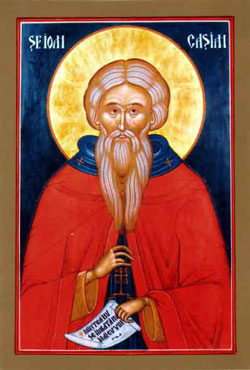
Feastday: June 22
A close friend of St. Paulinus of Nola, St. Nicetas was bishop of Remesiana in Dacia (modern Romania and Yugoslavia) and was noted for his successful missionary activities, especially among the Bessi, a race of marauders, which Paulinus commemorates in a poem. Nicetas wrote several dissertations on faith, the creed, the Trinity, and liturgical singing, and is believed by some scholars to be the author of Te Deum. We know little of Nicetas himself beyond the fact that on at least two occasions, he made his way from a country which Paulinus regarded as a wild region of snow and ice to visit his friend at Nola in Campania. St. Jerome also speaks very appreciatively of his work in converting the people of Dacia, but of the details of his missionary expeditions, the manner of his promotion to the episcopate, or the date of his death, we know nothing. His feast day is June 22nd.
 Miniature from the Menologion of Basil II
Miniature from the Menologion of Basil II
Saint Nicetas of Medikion (Greek: Νικήτας Μηδικίου) or Nicetas the Confessor (Νικήτας ο ομολογητής), who is commemorated on 3 April, was a monk who opposed Byzantine Iconoclasm.
Life
Nicetas was born in Bithynian Caesarea of a pious family. His mother died eight days after his birth, and his father Philaretos became a monk. The child was raised by his grandmother. From his youth Nicetas attended church and was a disciple of the hermit Stephen.
At a relatively young age Nicetas joined the Medikion monastery (μονή Μηδικίου) where Nicephorus was the hegoumenos (similar to abbot). In 790, After seven years at the monastery, Nicetas was ordained presbyter. When Nicephorus became ill, he entrusted to Nicetas the guidance of the monastery, and when Nicephorus died, Nicetas was chosen hegoumenos by the monks. His piety drew many others to join and follow him at the monastery.
Twice he was imprisoned for taking stands against the heresy of Iconoclasm. According to the Russian and Serbian “Synaxars” his courageous opposition to the iconoclasts resulted in his exile, at the beginning of the 9th century, during the reign of Leo V the Armenian in Byzantium. Upon the death of the Emperor Leo, Nicetas was released, but rather than return to Medikion retreating to an austere life in a monastery near Constantinople, where he died in 824. His remains were brought back to the monastery of Medikion.
In his Canon, written by the Constantinopolitan hieromonk, Saint Joseph the Hymnographer, the life led by Saint Nicetas was described as ascetic, God–pleasing, and full of charity. He is mentioned as a wonderworker, with the gift of healing.
References to St. Nicetas have been found in old manuscripts originating from the Greek Orthodox Patriarchate of Jerusalem, and in menaia from the Orthodox Patriarchates of Serbia and Russia. A church, first constructed in the 18th century, was dedicated to him on the Greek island of Lefkas.

